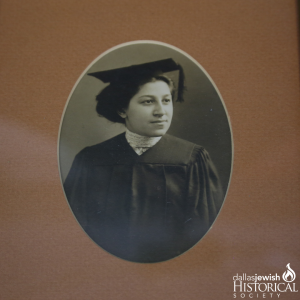by DJHS Archivist | Oct 28, 2020 | From the Archive |
Anne Garonzik was born in Pennsylvania in 1892. She was married to Charles Goodman during the month of February 1920 in Dallas, as it was announced in The Jewish Monitor. Before she was married, the January 1920 Census conducted in Dallas, shows she was located at 1409 South Akard, was 27 years old, both of her parents were from Russia, and she was a bookkeeper for the Mail House Order. She eventually was mother to Idelle Rabin, who donated items to DJHS, including her mother’s graduation photo. The photo is framed in a gold frame, with a beige oval mat. She is wearing a cap and gown with what appears to be a lace blouse or dress underneath.

Idelle Rabin Collection – Acc.# 2019.003
http://bit.ly/annegaronzikancestry
https://texashistory.unt.edu/ark:/67531/metapth296748/m1/4/?q=%20Anne%20Garonzik
by DJHS Archivist | Oct 8, 2020 | From the Archive |

Here we have various colored plastic and wooden dreidels. Dreidel is Yiddish for “spinning top”. The Hebrew letters inscribed on a dreidel are Nun, Gimel, Hey or Chai, and Shin. The letters form an acronym for the Hebrew saying Nes Gadol Hayah Sham, which can be translated to “a great miracle happened there,” referring to the miracle which Hanukkah is centered around.
The custom of playing dreidel on Hanukkah is based on a legend that, during the time of the Maccabees, when Jewish children were forbidden from studying Torah, they would defy the decree and study anyway. When a Greek official would come close they would put away their books and take out spinning tops, claiming they were just playing games. To play dreidel, each player begins with an equal number of game pieces, which can be coins, candies, nuts etc. At the beginning of each round, every player puts one game piece into the center “pot”. Players then take turns spinning the dreidel. When the top lands on nun, the player gets nothing; on gimel, the player gets the entire contents of the pot; hey, the player gets half of the pot; and shin, the player must put a game piece into the pot.
https://www.chabad.org/holidays/chanukah/article_cdo/aid/603267/jewish/What-Is-a-Dreidel-Sevivon.htm
https://www.myjewishlearning.com/article/dreidel/
by DJHS Archivist | Oct 6, 2020 | From the Archive |

Samuel Charles Blumenthal’s (1893-1978) WWI dog tags are located in the DJHS archive. Before World War I, Mr. Blumenthal lived in Georgia and was 23 years old. His name is stamped along the curved top edge of the alluminum tag. After July 26, 1918, all tags could be stamped with the letter indicating religion, i.e. “C”, “H”, or “P”. Mr. Blumenthal didn’t have H for Hebrew on his tag but it looks like he scratched a Star of David on his tag. His service number punched in the middle.
The dog tag was introduced to military srvice members in December 20, 1906. During the American Civil War there were so many unknown casualties that the American government decided soldiers needed to carry an identifying tag with them. What started as a single circular aluminum disc to be worn as an identification tag became required in 1913, and in 1916 the second dog tag was required–one to identify the soldier, and one to mark a coffin or burial site. The World War I dog tag was aluminum, the size of a silver half dollar, and imprinted with the individual’s name, rank, regiment, and branch of service to be worn around the neck. Eventually they switched to rectangular shaped dog tags during WWII which is the shape we often think of dog tags.
https://www.medalsofamerica.com/blog/the-history-of-dog-tags
https://www.med-dept.com/articles/u-s-army-ww2-dog-tags/
http://freepages.rootsweb.com/~cacunithistories/military/American%20Dog%20Tags.html
by DJHS Archivist | Oct 1, 2020 | From the Archive |

There’s an ancient Jewish custom called Bedikat Chametz (literally, “the search for Chametz). The night before Passover there is a search for any food that’s made of grain and water that have been allowed to ferment and “rise”. The candle is for light when searching, the feather is used as a broom, and the spoon as a dustpan. The next morning you are to burn the items used to find the Chametz, as well as any of the found Chametz. In the DJHS archive, we have a Bedikat Chametz kit along with the instructions for the blessing.
chabad.org/library/article_cdo/aid/1172862/jewish/The-Feather-the-Spoon-and-the-Candle.htm
https://www.thejc.com/judaism/features/judaism-101-what-is-bedikat-chametz-1.461010
by DJHS Archivist | Sep 29, 2020 | From the Archive |

This is a nurse’s uniform hat from the Red Cross from around August 1948. The online guide states: Indoor Uniform: Figure 73 Commando blue seersucker or blue poplin (latest selection since seersucker no longer obtainable) one-piece dress with either long or short sleeves, convertible collar, and 2-inch woven red cross on the upper pocket. Cap: Matching buttoned cap with 1-inch red cross centered on front of facing.
https://www.worthpoint.com/worthopedia/vintage-blue-wwii-nurse-nurses-1927456632
https://collectarc.com/Uniform%20Guide.pdf
by DJHS Archivist | Sep 24, 2020 | From the Archive |

Here we have a metal shoehorn from the E. M. Kahn and Company, “Complete Outfitters to Men & Boys,” which was located on Main and Elm, at Lamar. The founder Emanuel Meyer Kahn, a Jewish immigrant from Alsace-Lorraine, France, founded the E.M. Kahn Company in Dallas in 1872 at the age of 21. He was one of the first businesses in Dallas to put price tags on his merchandise, rather than haggling, which was normal with customers. The company was a retailer of menswear and eventually had girls and women’s departments, with multiple locations.
The business continued for ninety-two years as a family-owned business and had the distinction of being the oldest retail store in Dallas, as well as the city’s first air-conditioned store. It was known that E. M. Kahn, always stood out in a crowd, immaculately dressed in a chocolate-brown suit.
https://www.tshaonline.org/handbook/entries/kahn-emanuel-meyer
http://dallasmemorabilia.blogspot.com/2015/07/em-kahn-co.html
https://www.dmagazine.com/publications/d-magazine/2008/november/the-jews-who-built-dallas/
https://infoweb.newsbank.com/resources/doc/nb/image







Recent Comments